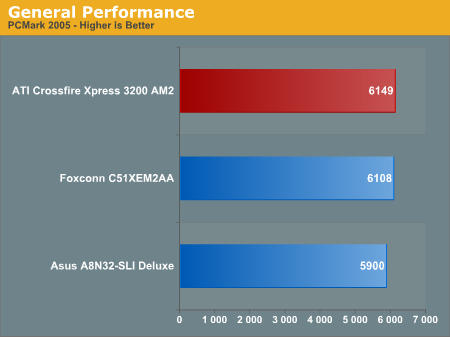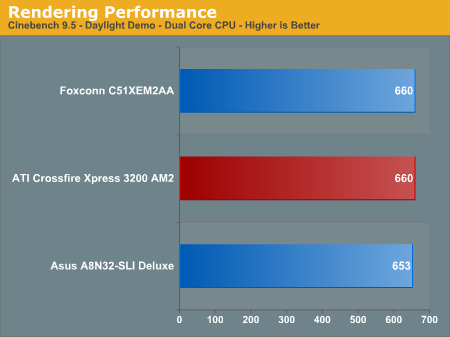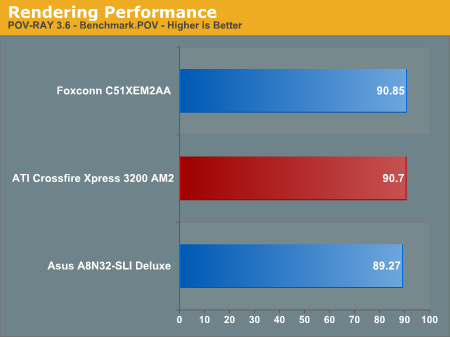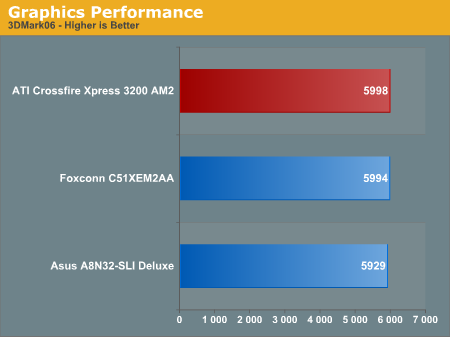CrossFire Xpress 3200: RD580 for AM2
by Wesley Fink on June 1, 2006 12:05 AM EST- Posted in
- Motherboards
General Performance
With the Memory Controller on the Athlon 64 Processor, Winstone benchmarks are no longer very revealing of motherboard performance. With the same CPU (and the same memory controller on that CPU) Winstones, both Business and Multimedia Content Creation, are tightly clustered. The only deviation from that is that boards that are tweaked for best gaming performance are often near the bottom of a tight range of benchmark performance numbers. The Winstone tests themselves are rapidly becoming dated, and are no longer supported by PC Magazine. While Winstones are still useful in providing real world performance data we are dropping Winstones from our standard motherboard test suite.

PCMark 2005 results with the ATI AM2 show the CrossFire Xpress 3200 AM2 with a 40 point lead. The nForce 590 and ATI AM2 should be considered equivalent in performance. Both show a 200+ point lead over the DDR-based Asus A8N32-SLI, consistent across both AM2 platforms.
Despite the close results in these tests, PCMark05 is proving to be a useful overall performance benchmark. It is generally more sensitive than the older Winstones and PCM04 to recent improvements in PC architecture. PCMark 05 results in general relate well to the other performance results we find in our board tests - providing a quick and reliable snapshot of board performance compared to other motherboards.



We have replaced Winstones with 2 benchmarks that use rendering to test system performance. Cinebench 9.5 and POV-RAY 3.6 benchmarks both heavily stress the CPU subsystem while performing graphics modeling and rendering. We utilize the standard benchmark demos in each program along with the default settings. Cinebench 9.5 features two different benchmarks with one test utilizing a single core and the second test showcasing the power of multiple cores in rendering the benchmark image.
Single-Core and POV-Ray results are extremely close across DDR and DDR2 platforms. However, Dual-Core Cinebench results show both NVIDIA and ATI AM2 chipsets with a larger lead over the DDR platform. Since all 3 systems were tested with a dual-core CPU at the same speed, this provides a bit of evidence that dual-core (and quad core potentially) can make better use of the extra DDR2 memory bandwidth.
3D Graphics
The 3DMark benchmarks, published by Futuremark, are probably the most widely quoted gaming performance benchmarks available. While the benchmarks are based on game sequences written by Futuremark to reveal subtle differences in gaming performance, they still have to be considered synthetic benchmarks. They are useful for broad graphics comparisons, but they are no substitute for benchmarks with real gaming engines that are currently being played.
SLI and CrossFire are also generally supported in 3DMark, but we ran 3DMark2005 and 2006 in standard mode only as we are not comparing SLI and CrossFire in this chipset review. Please take a closer look at CrossFire benchmarks later in this review for comparisons of CrossFire and SLI performance in several current games. 3DMark06 was recently introduced and you can find more in-depth information about this new 3DMark in the AnandTech article Futuremark's Latest Attempt: 3DMark06 Tested.


The 05 and 06 results both show the ATI AM2 in the lead, but the margin is small enough to be within the margin of error. Again, both AM2 boards outperform the DDR platform by several hundred points. The ATI and NVIDIA AM2 boards can be considered a dead heat in 3D Graphics performance.
Encoding
We have found encoding results are not affected by the graphics card used during the encoding benchmarks. This is demonstrated again and again by archive test results for AutoGK using an AMD 4000+ processor with a wide assortment of video cards. The performance range of those encoding tests is just 48.1 to 49.1 - a difference form high to low of just 1.0 frame. Clearly the biggest influence on this encoding benchmark is the CPU used for testing. Because encoding test results vary so little on the same standardized motherboard test platform, they have been dropped from this review and future reviews. Encoding tests are very useful in CPU testing, but they have been shown to be poor motherboard tests - particularly on the AMD platform with the memory controller on the CPU.
With the Memory Controller on the Athlon 64 Processor, Winstone benchmarks are no longer very revealing of motherboard performance. With the same CPU (and the same memory controller on that CPU) Winstones, both Business and Multimedia Content Creation, are tightly clustered. The only deviation from that is that boards that are tweaked for best gaming performance are often near the bottom of a tight range of benchmark performance numbers. The Winstone tests themselves are rapidly becoming dated, and are no longer supported by PC Magazine. While Winstones are still useful in providing real world performance data we are dropping Winstones from our standard motherboard test suite.

PCMark 2005 results with the ATI AM2 show the CrossFire Xpress 3200 AM2 with a 40 point lead. The nForce 590 and ATI AM2 should be considered equivalent in performance. Both show a 200+ point lead over the DDR-based Asus A8N32-SLI, consistent across both AM2 platforms.
Despite the close results in these tests, PCMark05 is proving to be a useful overall performance benchmark. It is generally more sensitive than the older Winstones and PCM04 to recent improvements in PC architecture. PCMark 05 results in general relate well to the other performance results we find in our board tests - providing a quick and reliable snapshot of board performance compared to other motherboards.



We have replaced Winstones with 2 benchmarks that use rendering to test system performance. Cinebench 9.5 and POV-RAY 3.6 benchmarks both heavily stress the CPU subsystem while performing graphics modeling and rendering. We utilize the standard benchmark demos in each program along with the default settings. Cinebench 9.5 features two different benchmarks with one test utilizing a single core and the second test showcasing the power of multiple cores in rendering the benchmark image.
Single-Core and POV-Ray results are extremely close across DDR and DDR2 platforms. However, Dual-Core Cinebench results show both NVIDIA and ATI AM2 chipsets with a larger lead over the DDR platform. Since all 3 systems were tested with a dual-core CPU at the same speed, this provides a bit of evidence that dual-core (and quad core potentially) can make better use of the extra DDR2 memory bandwidth.
3D Graphics
The 3DMark benchmarks, published by Futuremark, are probably the most widely quoted gaming performance benchmarks available. While the benchmarks are based on game sequences written by Futuremark to reveal subtle differences in gaming performance, they still have to be considered synthetic benchmarks. They are useful for broad graphics comparisons, but they are no substitute for benchmarks with real gaming engines that are currently being played.
SLI and CrossFire are also generally supported in 3DMark, but we ran 3DMark2005 and 2006 in standard mode only as we are not comparing SLI and CrossFire in this chipset review. Please take a closer look at CrossFire benchmarks later in this review for comparisons of CrossFire and SLI performance in several current games. 3DMark06 was recently introduced and you can find more in-depth information about this new 3DMark in the AnandTech article Futuremark's Latest Attempt: 3DMark06 Tested.


The 05 and 06 results both show the ATI AM2 in the lead, but the margin is small enough to be within the margin of error. Again, both AM2 boards outperform the DDR platform by several hundred points. The ATI and NVIDIA AM2 boards can be considered a dead heat in 3D Graphics performance.
Encoding
We have found encoding results are not affected by the graphics card used during the encoding benchmarks. This is demonstrated again and again by archive test results for AutoGK using an AMD 4000+ processor with a wide assortment of video cards. The performance range of those encoding tests is just 48.1 to 49.1 - a difference form high to low of just 1.0 frame. Clearly the biggest influence on this encoding benchmark is the CPU used for testing. Because encoding test results vary so little on the same standardized motherboard test platform, they have been dropped from this review and future reviews. Encoding tests are very useful in CPU testing, but they have been shown to be poor motherboard tests - particularly on the AMD platform with the memory controller on the CPU.










71 Comments
View All Comments
Stele - Friday, June 2, 2006 - link
Odd that the board uses two 3132s to provide the extra 4 ports - probably for logistic and pricing reasons (easier to stock and better economy of scale when buying 2x one chip compared to 2 different chips).I say it's 'odd' because the 3132 was specifically designed to work with port multipliers, specifically their SiI 3726 1-to-5 drive multiplier. The 3132 thus has only 2 ports to save space and costs (for customers who only need 2, e.g. laptops). In this motherboard's case, instead of having two 3132s giving 4 ports, you could use one 3132 and one 3726 to provide (1 + 5 =) 6 extra SATA ports via the 3132, bringing the total number of SATA ports on the motherboard to 10.
Indeed, this would probably be a useful combination: 4 from the SB600, 4/5 from the 3726 and the remaining 1/2 routed to the back as eSATA. For routing simplicity, I suspect board designers may keep all the ports from the 3726 in one cluster near the IC and hence as internal SATA, leaving the 3132's other channel available for eSATA.
While we're on the SATA question, I'd like to ask if anyone has any confirmation about the RAID levels supported by the SB600. This is because on pg 2 of the AT review, it mentions in the diagram that SB600 supports, inter alia, RAID 5. However, on pg 3, the table does not list RAID 5 among the supported RAID levels.
I then went to ATi's website to check out their own pages on the SB600. Interestingly enough, there was the same problem - the diagram was also there, showing RAID 5, but their own spec sheet does not mention RAID 5 either! So does the SB600 support RAID 5 or doesn't it? :P
Chadder007 - Thursday, June 1, 2006 - link
I wish ATI and NVidia would get off of this Dual Card setup crap and get their act together and make a Single Dual Core video card, in the way Dual Core Processors are being made now.Trisped - Thursday, June 1, 2006 - link
That would be nice, but the power drain and heat dissipation problems would be un real. Then people would still want a dual card solution. I can see it now, you need a 1K power supply for your video cards and one for the rest of your system. Your video cards take up 6 slots and have fans that sound like a 1960s sports car. Your CPU has 4 cores and everything is over clocked 25-50%.JarredWalton - Thursday, June 1, 2006 - link
There have actually been several dual GPU cards released in the past, although all of them still require SLI motherboards in order to function. (The SLI requirement is due to NVIDIA's drivers requiring an SLI chipset in order to function.) As far as making dual core GPU -- like the Pentium D, Athlon X2, Core Duo, etc. -- there's actually no point in doing so. Graphics functions are essentially infinitely parallel, so rather than making a dual core G70, they could just make a 48/16/32 (pixel pipelines/vertex pipelines/ROPs) chip instead. Of course, that would require something like 600 million transistors, so until we start getting GPUs made on 65 nm aren't likely to see such a design (or anything close to it).peternelson - Thursday, June 1, 2006 - link
On MAJOR difference not covered is in useable PCIE lanes.
The review talks about
x16 graphics
x16 graphics
no useable pci remain on the reference board
1x pcie
1x pcie
whereas the nvidia 590 solution offers much more including pcix4.
This is important for people who want to stick in extra raid controllers or specialist cards.
It would be good to highlight this shortcoming and whether it is purely down to the reference motherboard design or to the chipset not supporting as many lanes as the 590.
Also you mention that nvidia are working on putting both x16 in some future northbride (which will be nice). Can you give any hints as to timing, naming, or if this will be dubbed "nforce 6"
Wesley Fink - Thursday, June 1, 2006 - link
We are expecting a bit more information and we will then add this to our comparison chart.ATI RD580 AM2 has 40 PCIe Lanes - 32 for 2 x16 slots, 4 for interconnect between North and South bridge and 4 available for x1 x2, x4 slot(s). In addition the SB600 supports 6 PCI slots.
nVidia has 46 PCIe lanes available with 9 links.
psychobriggsy - Thursday, June 1, 2006 - link
This review says there is GigE in SB600, with a PCIe attached PHY.It also says that nVidia's dual GigE is via PCIe attached PHYs. PHYs do not connect via PCIe, they connect to a GigE controller (whereever it is located).
In the case of nVidia, the southbridge has two GigE controllers integrated. In the case of SB600, there is no GigE controller, you attach it via PCIe x1, allowing you to use decent controllers, or crappy realtek controllers (making motherboard purchases have another thing to check).
Stele - Friday, June 2, 2006 - link
That's probably what ATi's thinking. There are pros and cons to both nVidia's ondie MAC and SB5600's lack of ondie MAC. By having no controller on the SB600, the chip cost is reduced while motherboard manufacturers have complete freedom to choose whichever controller they would like to include - Marvell, Realtek, etc. and single- or dual-port.
The only downside is that you'd need extra real-estate on the motherboard, though arguably it's not that big a deal, especially if controllers with built-in MAC and PHY are used. After all, for dual-port networking capabilities that has server-like features like teaming and fail-over, manufacturers can just use such products as the very attractive Marvell 88E8062 PCIe x4 dual-port GbE controller - which some motherboards like the Asus P5WDG2-WS already do.
Indeed, I'm hoping (dreaming?) that at least one of the top motherboard brands would use this controller in their RD580 solutions, but the fact that the controller is likely going to be quite expensive, along with the perceived lack of the need for such a high-end component would probably kill that idea.
Wesley Fink - Thursday, June 1, 2006 - link
BOTH the ATI and nForce 590 use PHYs that connect to the chip and communicate over a PCIe lane. We were merely differentiating that the Gigabit LAN in both cases communicated over PCIe and was not connected to PCI. nVidia has 2 Gigabit PHY connections, while ATI has 1 Gigabit PHY connection.peternelson - Thursday, June 1, 2006 - link
He's right, the PHY (external or internal) connects to the MAC, which is subsequently connected to the pcie lanes. No pcie goes to any Gbe PHY.